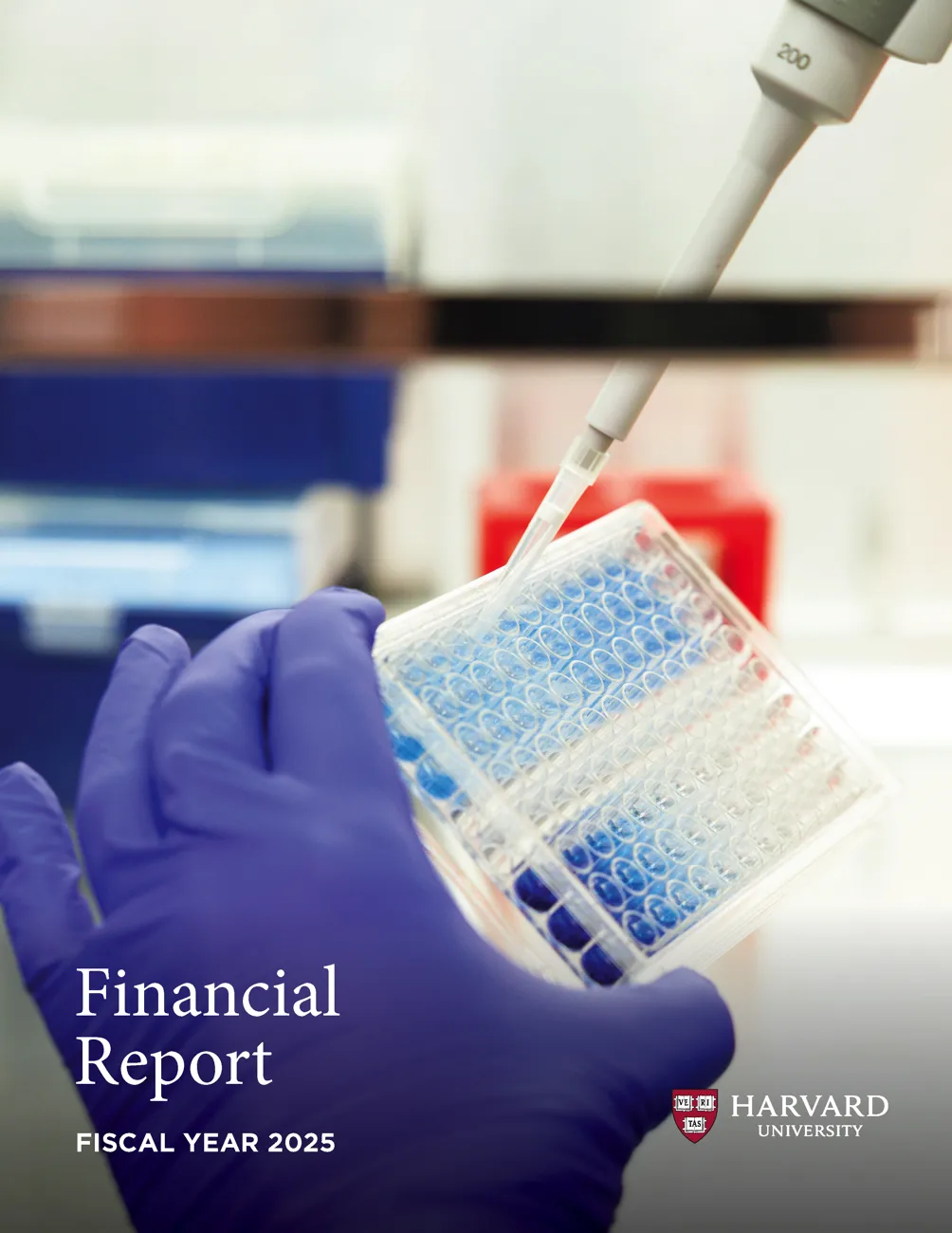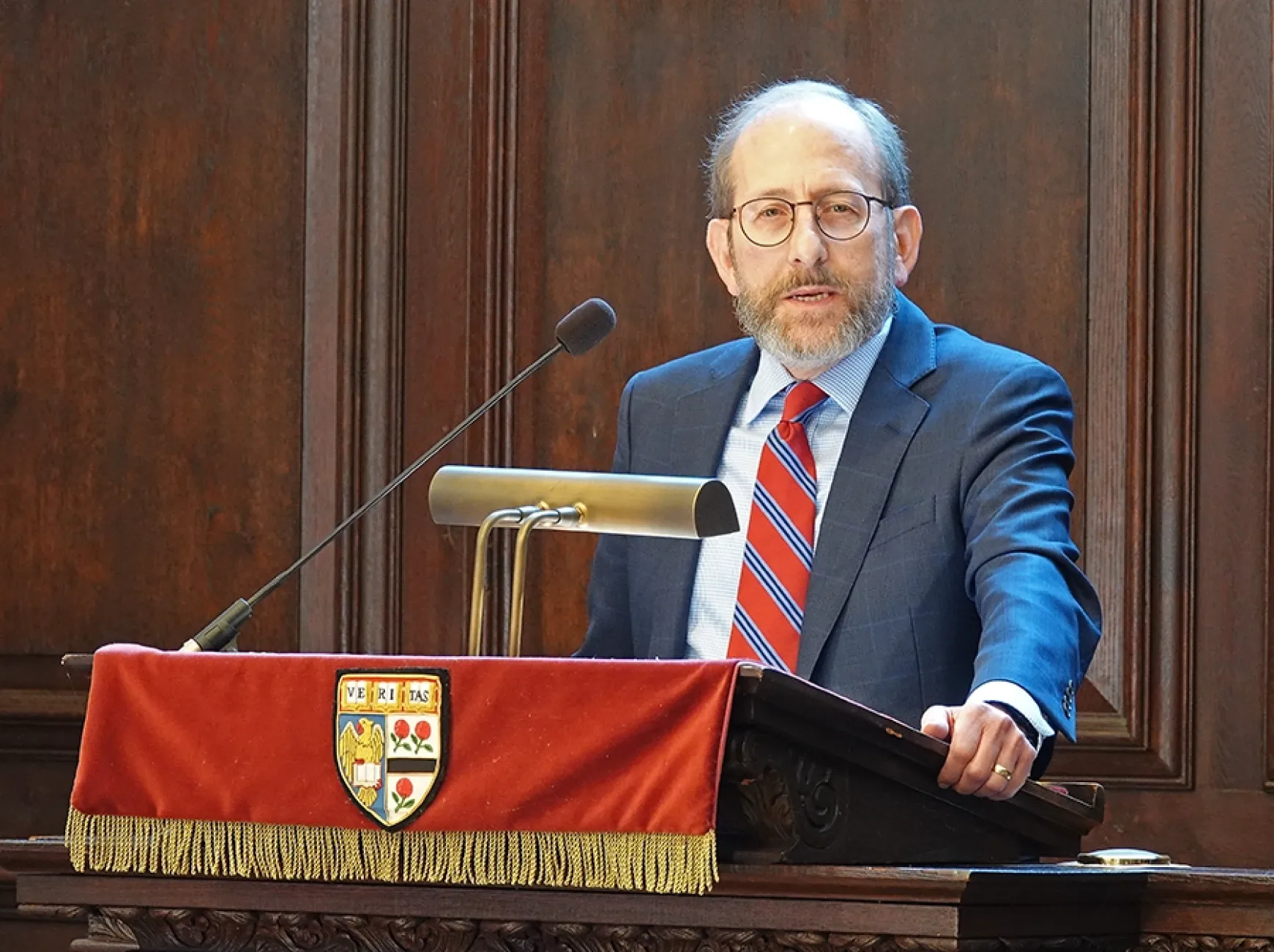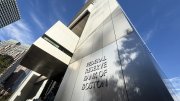Harvard’s annual financial report for the fiscal year that ended on June 30, 2025—showing a $113 million operating deficit—reflects some effects of the Trump administration’s unprecedented fiscal and regulatory assault on the University and much of higher education. Perhaps more importantly, the report published on Thursday suggests the severe financial and academic challenges on the horizon, as the federal government fractures its research partnership with higher education, imposes a sharply higher tax on the endowments of leading universities, and tries to limit foreign students’ enrollment, among other changes that would fundamentally alter higher education and the social benefits it generates, in Cambridge and across the United States.
In the past few years, University financial leaders had cautioned that expenses were growing faster than revenues, reflecting recovery from the pandemic: a financially unsustainable path. During fiscal year 2025, revenue and expense growth both decelerated—but expenses rose nearly twice as fast as revenues, yielding the first operating deficit in more than a decade. Ominously, that reflected only a few months of the Trump administration’s suspension of research funding, and of Harvard’s legal and other expenses incurred in defending its rights.
Another financial development that’s surely tied to the political climate—and reflects some rallying on the University’s behalf among individuals and groups of alumni—is a sizable increase in donations to Harvard. In fiscal year 2025, gifts for current use increased by nearly 20 percent.

In other positive news, the investment return on endowment assets rose smartly, increasing the endowment’s value overall—key metrics, since distributions from the endowment remain by far Harvard’s largest source of operating revenues. Highlights include:
The University recorded a $113 million operating deficit, following a relatively modest $45 million surplus in fiscal year 2024. Revenues rose 3 percent to $6.7 billion, and expenses 6 percent to $6.8 billion. Revenues were reduced by $116 million just during the last months of the fiscal year, as the federal government terminated grants and suspended funding on research contracts. (Those actions have largely been reversed in the current fiscal year, 2026, following a federal district court ruling, but the matter remains in litigation.) The expenses include some nontrivial costs for complying with the government’s repeated demands for information and Harvard’s lawsuits challenging federal regulatory and other actions.
In a good year for institutional investors—particularly those weighted toward public equities—Harvard Management Company (HMC) realized a net 11.9 percent rate of return on endowment investments, up from the 9.6 percent reported in fiscal year 2024.
The aggregate endowment investment gains and income of $5.8 billion, reduced by the $2.5 billion distributed to Harvard’s operating budget (in turn partially offset by $400 million in gifts for endowment, plus other changes and transfers), increased the endowment’s value by a meaningful $3.7 billion, to $56.9 billion as of June 30, 2025, up nearly 7 percent from $53.2 billion one year earlier. But beginning in the next fiscal year, if investment returns remain strong, the tax owed on endowment investments could rise very significantly—perhaps to $300 million or more—limiting the funds distributable for financial aid, research, and other academic spending.
“A Crucible of Change”
In the measured voice that he has maintained throughout an unprecedented year, President Alan M. Garber began his message in the annual report by noting, “Even by the standards of our centuries-long history, fiscal year 2025 was extraordinarily challenging, with political and economic disruption affecting many sectors, including higher education.” He wrote that the University is continuing “to adapt to uncertainty and threats to sources of revenue that have sustained our work for many years”—by seeking new sources of funding and by “examining operations at every level of the University as we seek greater adaptability and efficiency.”

Mindful of other issues surrounding Harvard and higher education, he said, “[W]e continue to ensure that our academic environment nurtures excellence in all of our endeavors. We are promoting open inquiry, constructive dialogue, and viewpoint diversity, and pursuing our priorities with the resolve that the times demand.” In parallel, he focused on the core mission of this and other universities: “Our research continues to deepen understanding and to yield tangible benefits—better health, longer lives, and greater security among them. As we pursue excellence in the discovery and dissemination of knowledge, we better serve people across the country and around the world.” (The report devotes two pages to research on such life-changing subjects as tuberculosis treatments, better reading instruction for children, understanding neurodegenerative diseases, and the influence of environmental exposures on respiratory health.)
And at this fraught moment, he especially thanked University supporters, who “are united by the conviction that Harvard is not a paragon of perfection but a crucible of change.” He cautioned that the course ahead “will no doubt be among the most difficult and demanding periods” in University history.
The financial management leadership, Ritu Kalra, vice president for finance and chief financial officer, and Timothy R. Barakett, the University’s treasurer, used their letter to suggest exactly what those difficulties might entail. They wrote:
We began the year with challenges already in view: expenses rising faster than revenues, inflationary pressures amid broader economic uncertainty, and the ongoing work of renewing and rebuilding our community. We closed it confronting the abrupt termination of nearly all of Harvard’s federal research grants, facing potential constraints on the exchange of international scholars, and considering how we will absorb the enactment of a substantial increase to the federal tax on endowment income, scheduled to take effect in fiscal 2027.
The consequences, they warned—that $113 million deficit—“are only beginning to be felt.” In fact, they wrote, “this result could have been worse,” had Harvard not determined to leave open positions unfilled, defer discretionary capital projects, freeze salary increases for nonunion staff, and, yes, effect “targeted workforce reductions.”
At the same time, they observed, Harvard continued to increase financial aid, offering more than $750 million in fiscal year 2025, up nearly 5 percent from the prior year. The University is also continuing to invest in new arts and education facilities in Allston. Harvard was able to do so, they acknowledged, because of the strength of the endowment (the fruits of past philanthropy) and a record level of current-use giving: more than $600 million during the year.
This bifurcated message—daunting challenges but encouraging resiliency—should be seen in perspective. During the financial crisis and Great Recession of 2008 and after, the value of University financial resources was reduced by about one-third, virtually overnight. It took more than a decade of careful financial stewardship, spending restraint, favorable investment returns on endowment assets, and a $9.6 billion capital campaign to bring Harvard’s finances back to par in inflation-adjusted terms. Painful as that was, it was a unidimensional, financial problem: adjusting aspirations, over an extended period, to the money in the till.
Today, as Kalra and Barakett have framed it, almost every aspect of the University’s operations and their financial underpinnings are under question, or attack, at the behest of the federal government:
Looking forward, daunting challenges await: the declining trajectory of federal research support, the forthcoming increase in the endowment tax, the still-unfolding challenges to our ability to host international students and scholars and ongoing litigation—all against the backdrop of serious geopolitical and economic pressures and the potential for significant inflation. Structural changes and reductions across our schools and units will be necessary, and they will not be easy. Our work is far from finished.
These are financial concerns, to be sure—potentially amounting to the permanent loss of hundreds of millions of dollars of resources annually—but they go to the heart of the academic mission of teaching and research. That realization has, perhaps, only begun to sink in.
The Fiscal Year in Review
REVENUE. Harvard’s operating revenue increased 3 percent during fiscal year 2025, to $6.7 billion from $6.5 billion in the prior year (all figures are rounded).
Looking at major sources, endowment distributions (37 percent of the total) rose from $2.4 billion to $2.5 billion: about 4 percent, down from the 6.6 percent growth in fiscal year 2024. The latest, moderate growth reflects the 2.5 percent increase in the distribution per endowment unit owned by schools, approved by the Corporation for fiscal year 2025, plus the increase in the number of units owned (from gifts).
These measured increases smooth the lagging effect of the outsized gains in the endowment’s value from fiscal year 2021, when the investment return was 33.6 percent, while buffering budgets from years of negative or only modestly positive returns, like 2022 and 2023. (How the stronger investment returns in fiscal years 2024 and 2025 will be reflected in later years is subject, of course, to the pending, nearly sixfold, increase in the endowment tax rate and the University’s overall financial position in the current political and economic environment.)
Net student income (22 percent of the total, reported after financial aid) increased $56 million, to $1.4 billion: up 4 percent, in line with the prior year’s growth. College enrollment, which had been elevated as undergraduates who took leaves or deferred admission during the pandemic resumed their programs, is returning toward more typical levels. Executive and continuing education continued to grow and is now a $600 million annual business—albeit subject to some competitive pressure, sluggish economic growth, and changes in federal government policy that affect public sector enrollment.
Sponsored support for research (15 percent of revenue, down a percentage point from fiscal year 2024) decreased by $40 million (4 percent). According to the annual report (emphasis added), “Prior to the suspension and termination of federal grants this spring, federal sponsored revenues were trending toward a 9 percent increase over fiscal year 2024. Instead, the University recognized $629 million in federal sponsored revenue…an 8 percent decrease.” The central administration made available $250 million of reserve funds, to which schools added resources, to sustain research, but these internal transfers do not count as revenue. (As noted, payments on federal grants reinstated beginning in September will be recognized as revenue this year—but the issue is subject to continuing litigation.) Non-federal sponsored research funding rose 6 percent, to $345 million, including both direct grants and support for indirect costs such as buildings and equipment (typically at rates far below those heretofore provided for in federally supported programs).
Gifts for current use (up a percentage point to 9 percent of revenue) increased an eye-popping $101 million, to $629 million (a robust 19 percent increase).
Other revenue, a catch-all category, decreased $34 million, to $849 million. The most notable item was a $50 million decrease in royalties from agreements to license intellectual property, which can fluctuate from year to year.
EXPENSES. The University spent $6.8 billion on operations in fiscal year 2025, up nearly $400 million, or 6 percent, from $6.4 billion in the prior year.
Salaries and wages rose $127 million (5 percent), to nearly $2.8 billion, reflecting wage increases, hiring, and some new programs (moderated by the hiring freeze implemented in March). Employee benefits spending increased $65 million, to $756 million (up 9 percent)—reflecting both the growth in the workforce and, of concern, accelerating healthcare costs.
Other expense categories exhibiting notable growth included space costs (up $70 million, or 6 percent), reflecting spending on deferred maintenance and the financing costs associated with construction, all at elevated costs.
One item meriting attention was the large services purchased category: $978 million in fiscal year 2025, up $57 million from the prior year. That line has soared from $665 million in fiscal year 2021. It rose particularly sharply—by $100 million—in fiscal year 2024, when government investigations of the campus protests following the Hamas terrorist attack on Israel and the ensuing war in the Middle East, and President Claudine Gay’s resignation, presumably prompted heavy legal and related expenses.
Given the timing of fiscal year 2025 developments—the Trump administration took office in January, so its information requests, demands, regulatory changes, and ensuing litigation date from then, accelerating as the spring semester progressed—one might expect such costs to be far higher during the full fiscal year 2026.
CAPITAL SPENDING. Harvard’s investment in fixed assets—buildings and equipment—rose to $927 million in fiscal year 2025 from $639 million in the prior year, approaching in nominal terms the billion-dollar level of outlays at the end of the last decade. The major current projects include the new American Repertory Theater facility and affiliate housing tower in Allston; the new economics department building between Littauer Center and the Law School; and renovation of Eliot House, the penultimate step in the program of renovating undergraduate residences (and most likely the most expensive to date). Most of this work continues in the current fiscal year.
Beyond such projects—funded by major gifts or deemed essential maintenance and facilities renewal—University financial constraints will require that the spigot for discretionary capital programs be turned off. Among the casualties is the Harvard Library’s ambition to reconfigure Widener, Lamont, Houghton, and Pusey, and to bring the fine arts collection back from its quarters in the basement of Littauer. It seems likely that Kirkland House renewal, another very big-ticket item, will be deferred.
THE BALANCE SHEET AND GIVING. Bonds and notes payable increased from $7.1 billion to $8.3 billion during the year, as Harvard issued $503 million in tax-exempt bonds (for current capital spending projects) and $750 million in taxable bonds (to support general University needs in the uncertain operating environment). Interest expense rose to $263 million from $225 million in fiscal year 2024. The effective interest rate on all of Harvard’s borrowings remains 4.1 percent, and the University maintains its AAA/Aaa credit ratings.
Liquid, short-term investments held outside the endowment to support operations were $2.4 billion at the end of fiscal year 2025, up from $1.8 billion a year earlier.
Total gift receipts (in which Harvard includes non-federal sponsored research grants) rose to $1.3 billion from $1.2 billion, driven by the surge in gifts for current use, to $629 million from $528 million in fiscal year 2024. Pledges receivable (including for current use, non-federal research support, construction, and endowment) were essentially level, at $2.6 billion in each year.
Endowment Results

Harvard Management Company’s reported 11.9 percent return (net of investment expenses) on endowment assets during fiscal year 2025 compares favorably to the 9.6 percent realized in the prior year. As HMC chief executive N.P. Narvekar emphasized in his letter (part of the annual financial report), the importance of the endowment looms ever larger: distributions “now [account] for nearly 40 percent” of the University’s annual operating revenue. Allowing himself somewhat of a (warranted) victory lap, he noted further that the fiscal year 2025 returns surpassed the targeted benchmark of 8 percent (meant to balance a 5 percent annual distribution rate and annual inflation of 3 percent or so, thus maintaining spending power for the long term). “Since the start of the current management team’s tenure eight years ago,” he continued, “the portfolio has generated an annualized return of 9.6 percent.”
For the third year in a row, the financial markets may have vexed managers of major endowments like Harvard’s, because public market indexes (again driven by a handful of large-capitalization technology stocks) and international equities (reflecting the weak dollar) tended to produce stronger results than those of large, diversified endowments, which invest heavily in private securities.
According to the Wilshire Trust Universe Comparison Service (TUCS), which assesses the performance of pension plans, endowments, and similar pools of assets, the median gross return of all such plans was 10.48 percent in fiscal year 2025. That trailed Wilshire’s measure of publicly traded U.S. and international stocks (15.21 percent and 17.72 percent returns for the year, respectively). For the year, all institutional investors in Wilshire’s universe underperformed a traditional 60 percent public stocks/40 percent bonds portfolio (driven by public stock appreciation), with larger, more diversified plans trailing the performance of smaller ones across the board, “due mostly to larger allocations to alternatives” such as private equity and hedge fund assets in the larger portfolios. Large plans in the TUCS cohort posted gains of 10.1 percent.
Among diversified endowments that have reported results to date, the University of Virginia Investment Management Company’s main asset pool gained 12.4 percent, up from 7.5 percent in fiscal year 2024, driven by a 20 percent return on public equities and 14.3 percent return on private equities (which collectively account for about 56 percent of invested assets). MIT earned a robust 14.8 percent on its pooled investments (up from 8.9 percent last year).
Characterizing Harvard’s results, Narvekar wrote, “Though endowment results in fiscal year 2025 were dampened by having less public than private equity,” HMC’s overall performance was bolstered by “discerning manager selection” (i.e., comparatively strong returns by the external firms HMC retains to invest the assets). He pointed to “returns well above…benchmarks” from public equity and hedge fund managers and “double-digit gains across diverse strategies and stages” of private equity investments.
Consistent with a multiyear increase in equity exposure—in concert with the University’s overall financial strategy and tolerance for risk—HMC’s asset allocation shifted slightly during fiscal year 2025. The report reveals that (allowing for rounding) the allocations to public equities (14 percent), real estate (5 percent), and other real assets and cash (3 percent each) were unchanged from fiscal year 2024. Hedge fund assets (31 percent of the total) and bonds and inflation-protected securities (4 percent) each declined a percent. And private equity holdings increased to 41 percent (up 2 percent).
This year’s HMC letter did shed a little light on the composition of those hedge fund and private equity strategies, which dominate Harvard’s endowment. The somewhat more detailed reporting helps explain that hedge funds retained by HMC are not solely public equity-related, and that private equity is not uniformly focused on leveraged buyouts or venture capital.
Thus, among the hedge fund assets, HMC reported that:
•long/short investments (principally, long and short equity positions) accounted for 9 percent of invested assets;
•multi-strategy holdings (whose managers employ multiple investment strategies, rather than focusing on a single asset class of tactic) and credit strategies (private lending and debt) accounted for 3 percent each; and
•“uncorrelated” hedges (diverse strategies—possibly including commodities, macro market views, quantitative trading, and so on—designed not to be benchmarked to public securities and market indexes) accounted for 16 percent. This large pool of funds is deemed critical to moderating HMC’s risk overall—and to ensuring that Harvard has sufficient liquidity to meet its needs across market cycles.
Private-equity holdings are divided among:
• buyout funds (where investors typically take control of a mature, profitable company), 13 percent;
• growth buyout strategies (partial investments and buyouts involving less leverage, in pursuit of organic growth), 4 percent;
• venture capital (seed capital for start-up and early-stage companies), 14 percent; and
• growth-venture funds (investments in the subsequent stages of growth of venture-backed companies, prior to their going public or being acquired), 10 percent.
Obviously, over the long term, as go the hedged and private equity holdings, so goes HMC’s performance.
The looming endowment tax. Given the centrality of endowment distributions to the University’s economic model, the rate of return on (and therefore of growth in) endowment assets are perhaps Harvard’s most important financial indicators.
But now another figure looms large. As of fiscal year 2027, beginning next July 1, Harvard’s endowment (along with those of a few other peers in similar financial circumstances) will be subject to an 8 percent tax on investment income and realized gains, up from the 1.4 percent rate levied under legislation enacted in 2017. In a sense, “endowment tax” is a misnomer, because the new tax regime, passed by Congress this past summer and still subject to the issuance of detailed implementing rules, covers all investment income, royalties resulting from federally sponsored research, and related revenues.
In fiscal year 2025, the University reported $173 million of income from general investments (including the endowment) and $6.5 billion in realized gains and the change in unrealized appreciation on such investments: a total of $6.7 billion, up from $5.2 billion in fiscal year 2024. For the endowment component alone, the total investment return (income and realized and unrealized appreciation) was $5.8 billion this year, up from $4.5 billion in fiscal year 2024.
Realized gains aren’t disclosed, but the University’s tax provision in its most recently reported Internal Revenue Service filings totaled $105 million, up from a $52 million provision for taxes and fees in fiscal year 2023. (These figures include several items and thus are not exactly equal to the provision for endowment taxes alone.) Beginning next fiscal year, if investment returns remain strong, the endowment tax levy could rise very significantly—perhaps to $300 million or more.
Since HMC and peer university investment teams cannot magically boost returns to offset the increased taxes, they may have to explore other changes in portfolio strategy and management. And Harvard fundraisers may have to consider how much to emphasize current-use giving, rather than philanthropy focused on endowed funds.
A year ago, Narvekar and his HMC colleagues were focused on refining their investment strategy and execution. Now, as he gently put it in this year’s report, “Increased taxation, while significant in the near term, also underscores the importance of protecting the endowment’s purchasing power over time. More will be required of the endowment to sustain the same level of academic excellence, magnifying the ethical and legal imperative to balance present needs with future obligations.” Writ large, the same challenge faces all University leaders as they steer Harvard through a much more hostile, and politicized, external environment.
A Threatening Environment
A year ago, Harvard treasurer Timothy Barakett was focused on the usual financial concerns. “The University has investments it must make in the near future,” he wrote, citing priorities from financial aid to the environmental sustainability of University operations. “In our planning for the years ahead,” he concluded, “we must create the financial capacity to make room for these investments.” How he, his fellow Corporation members, and the administration must long to return to those kinds of problems today.
Beyond the looming endowment tax—likely a permanent drag on Harvard’s resources—the Trump administration seems bent on slashing federal spending for biomedical, health, and physical sciences research nationwide. That includes both direct grants and the critical indirect cost provisions, which help defray institutional overhead. Of late, it has proposed conditioning such support on political criteria, rather than the traditional competitive evaluation of the scientific merit of proposals for funding. (The administration also maintains that Harvard is ineligible to receive any such support in the future.)
If such reductions and changes in grantmaking come about, they pose especially severe problems for the faculties of public health, medicine, and engineering and applied sciences, which have historically relied on sponsored research support (most of it from federal sources) for between one-third to as much as three-fifths of their annual revenue.
Already, Chan School of Public Health Dean Andrea Baccarelli has had to prepare his colleagues for the permanent loss of at least tens of millions of dollars in annual research funds. Medical School Dean George Q. Daley outlined comparable challenges in his 2025 state of the school address. Citing “a fundamental shift in the relationship between research universities and the federal government,” Paulson School of Engineering and Applied Sciences Dean David C. Parkes on October 9 announced “the difficult decision to lay off members of our staff and significantly restructure several offices” (The Crimson reported a 25 percent reduction in unionized clerical and technical support staff).
These actions suggest that the deans foresee lasting pressure on their basic finances and operations. Research support from foundation and corporate sponsors appears highly unlikely to make up for any shortfall in federal funding—and in any event is more focused on near-term and translational research than the fundamental science the government has underwritten for the past several decades.
In a blow to the broader educational mission, Faculty of Arts and Sciences Dean Hopi Hoekstra recently announced “significantly reduced” doctoral admissions for the next two years, accompanied by an evaluation of “the future model for graduate education in the FAS.” In a related development, the changing prospects for research and the federal government’s much more restrictive visa program have reduced foreign student arrivals nationwide by a reported 20 percent this year.
So far, Harvard enrollments do not appear to have been significantly reduced, but the federal policy remains in litigation. Over time, those pressures could lead to a gradual change in Harvard schools’ student bodies (and in the case of some of the schools, a change in the mix of students who receive significant financial aid versus those who have their own resources). Beyond the budgetary consequences, of course, changes in graduate and professional admissions have academic implications, limiting the composition and supply of undergraduate teaching fellows—and curtailing the training of future scholars.
The University faces plenty of other pressures, too. The College maintains a core commitment to need-blind admissions and competes with peers for students; amid all the looming financial problems, Dean Hoekstra last March unveiled enhancements in undergraduate aid (raising the threshold for free attendance to families with income of up to $100,000 and eliminating tuition for those whose income is $200,000 or less)—a real cost, since aid is not fully supported by endowed funds. Employee benefits—now exceeding three-quarters of a billion dollars annually, or about 11 percent of expenses—are once again inflating, as Massachusetts healthcare spending increases at a rate approaching 9 percent. As noted above, Harvard has undertaken substantial new borrowing; depending on how the proceeds are deployed in the near term, interest expense could rise further in fiscal 2026.
And a hoped-for source of future revenues, the commercial enterprise research campus (ERC) in Allston, may be a longer time in arriving. As a result of the federal squeeze on biomedical and related research funding and investors’ pivot from life sciences to artificial intelligence, Boston is plagued by an enormous oversupply of lab spaces (a reported 36 percent vacancy rate), depressing leasing and rents. Such facilities make up a large share of the first phase of the ERC, where space is being offered to prospective tenants but only one small lease has been reported. Leasing those lab buildings is crucial to making the project’s finances work and thus to subsequent stages of development from which Harvard hopes to receive growing cash flows from the developer. It may still—but later rather than sooner.
•••••
In this context, looking back at fiscal year 2025 is only a springboard to looking ahead, when the University will be called upon, as Ritu Kalra and Timothy Barakett vividly put it, to summon “Harvard’s ability to scale back when needed and build back with purpose.” In the months and years ahead, the entire Crimson community will need to enlist in both these efforts to weather the severe storm now at hand.
The 2025 annual financial report is posted at the Harvard financial administration website, along with the Harvard Gazette conversation about the financial results with executive vice president Meredith Weenick and vice president for finance and CFO Ritu Kalra.









